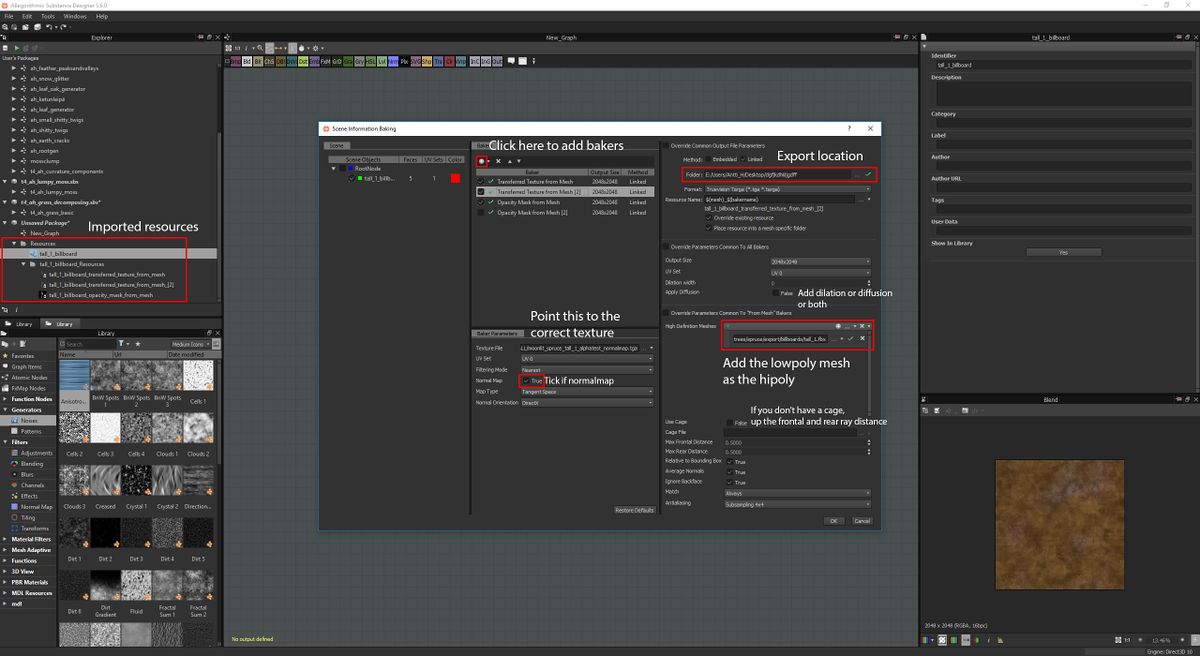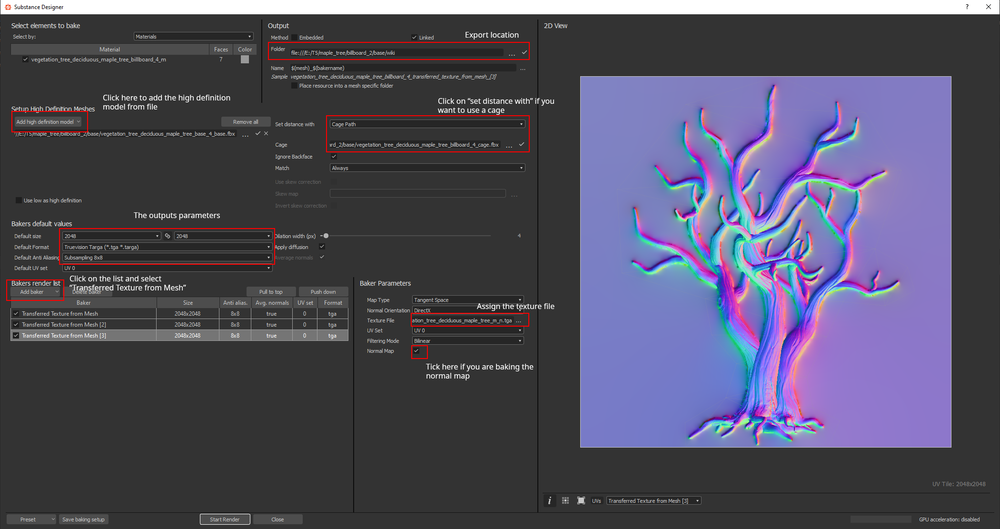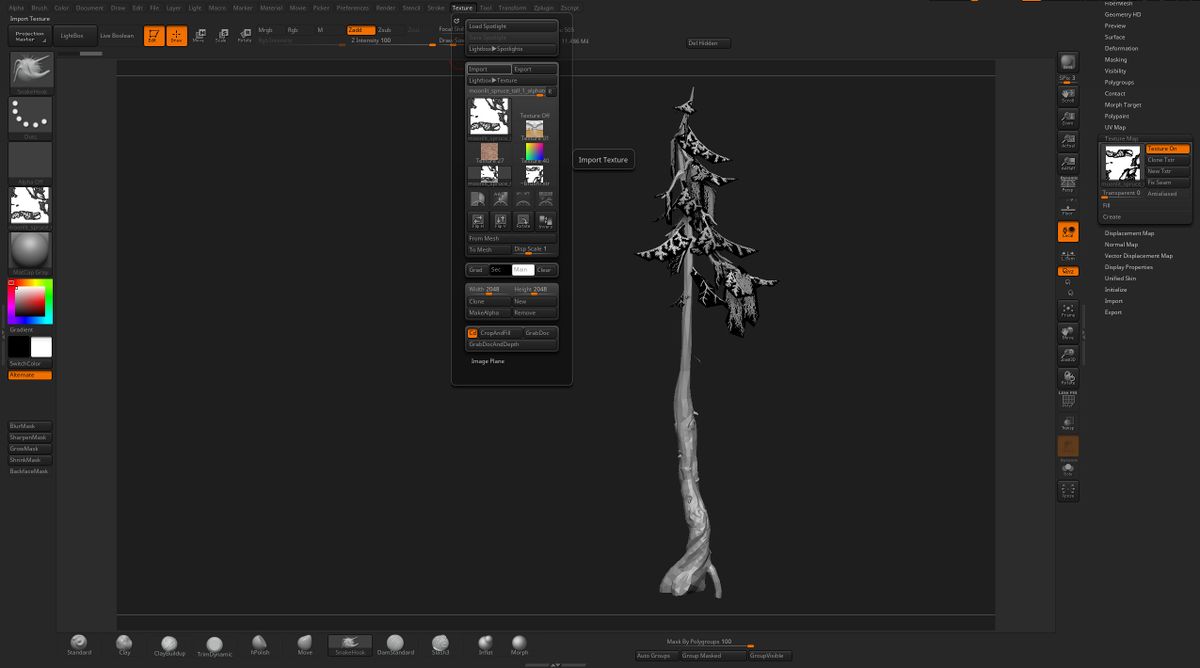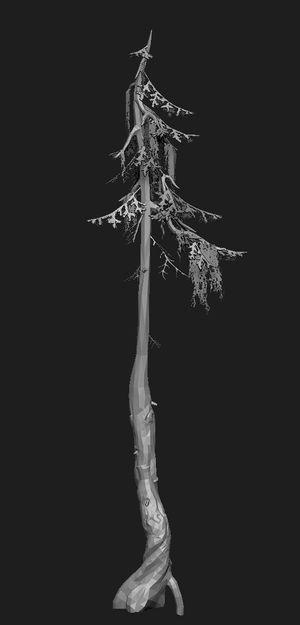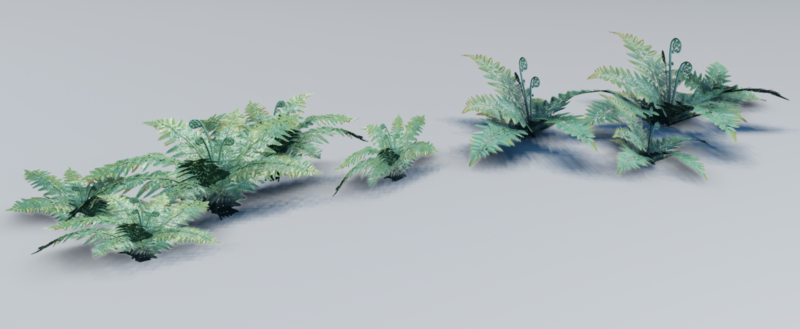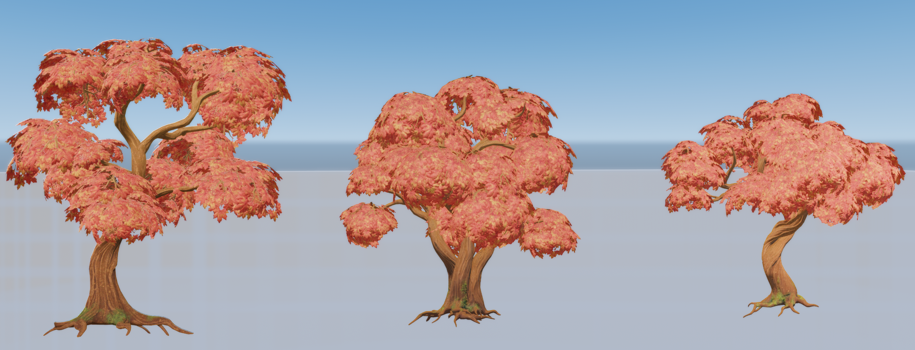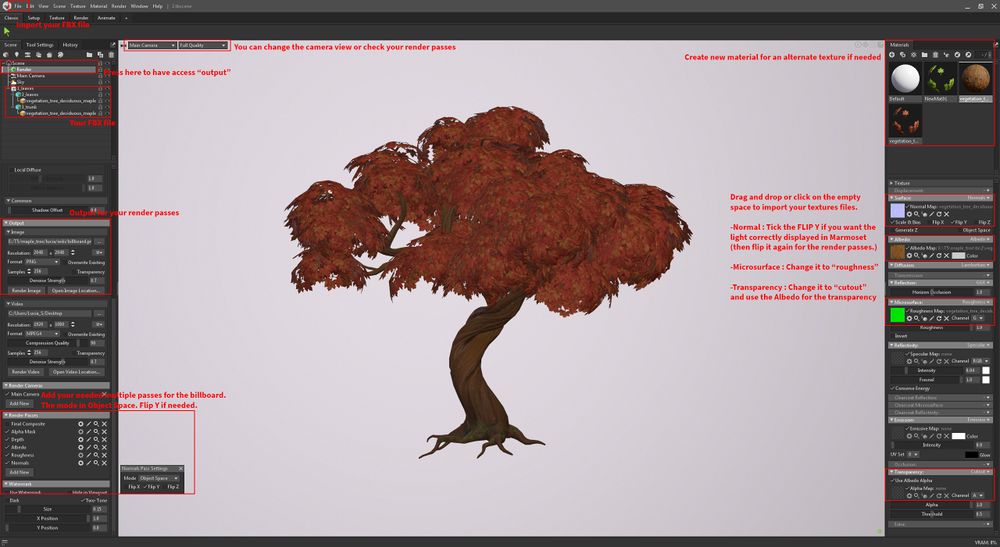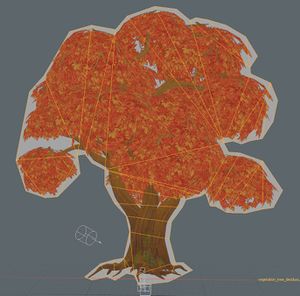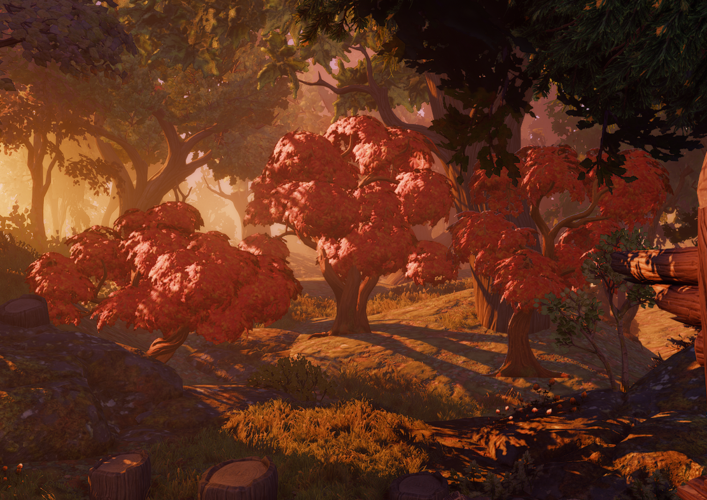3D Asset Workflow: Billboards
- ◇ Main Steps
- 3D Asset Workflow: Concepting
- 3D Asset Workflow: Sculpting
- 3D Asset Workflow: Retopology
- 3D Asset Workflow: UV Mapping
- 3D Asset Workflow: Baking
- 3D Asset Workflow: Texturing
- 3D Asset Workflow: Asset Assembling
- 3D Asset Workflow: Naming the Asset
- 3D Asset Workflow: LODs
- 3D Asset Workflow: Exporting to Editor
- 3D Asset Workflow: Completed asset checklist
- ◇ Additional Steps
- 3D Asset Workflow: Alternative Textures
- 3D Asset Workflow: Billboards
- 3D Asset Workflow: Blocksets
- 3D Asset Workflow: Collisions
- 3D Asset Workflow: Sikailu
- 3D Asset Workflow: Sway
- 3D Asset Workflow: Tile Textures and Trimsheets
- 3D Asset Workflow: Tintmask
- 3D Asset Workflow: Vegetation
- ◇ General Tips and Troubleshooting
Preparation
- This guide goes into detail on how to bake billboards using Substance Designer
- Export your game-/editor-ready low poly mesh as their own fbx-file
- You can have multiple meshes in a single file as long as they use the same texture maps and they are named properly
- Same way as if you were baking with Substance Painter
- See Baking with Substance Painter for reference
- You will also need the diffuse/albedo, normal map and specular map for the exported low poly
Create your billboard mesh
- Import your low poly mesh into Modo
- Go into front orthographic view by pressing numpad + 2 (revert to perspective with numpad + ,)
- Use the pen tool to draw a plane that covers the low poly mesh. Try to make the plane silhouette match the low poly as closely as possible to reduce the number of rendered transparent pixels.
- Connect the vertices (Ctrl + L when 2 vertices selected) and create a UV map
- Center the billboard and duplicate it to a new mesh layer
- Move the duplicate away from the low poly, until they no longer intersect
- Now you have 3 meshes: Game ready low poly (used as high poly), billboard plane (used as low poly), and the offset duplicate (cage)
- Export your billboard and cage as separate files
Substance Designer
- Open Substance Designer and make a new substance (File > New Substance, or Ctrl+N)
- Settings don't matter at this point, empty graph works as well as any other
- Right click on Unsaved package in the left side panel, and select Link > 3D mesh
- Select your billboard mesh
- The imported mesh can be found in the resources folder in the same panel
- Right click on the imported mesh and select Bake model information
Bakers
- In the dialog, click on the small + -sign in the middle panel labeled 'Bakers', and select Transferred texture from mesh
- Add 3 of them. Select each new entry and point them to albedo, normal and specular.
- Remember to tick Normal map -checkbox in the case of normal map
- Reference for Substance Designer bake settings:
- For the 2019 Substance Designer version. The UI is slightly different.
Bake parameters
- Most of these settings are the same as in Painter
- In the right side panel, select the export folder, output size and dilation amount and/or diffusion
- For the high definition mesh(es) select the game ready low poly
- Add the cage if you have one. If not, increase the Max Frontal and Rear distance until no clipping occurs.
- Match By mesh name if you are baking multiple meshes at once and have them properly named. Otherwise use Always. Antialiasing 4x4 or 8x8.
- Press OK to bake the maps
Baking the opacity/alpha
- For a opacity map, that has individual leafs and their back faces taken to account as well, start by importing your low poly tree into Zbrush
- In Zbrush Separate your leaf planes in to another subtool
- You can do this by using Auto Groups in polygroups menu, then hide all the leafs and in subtool menu -> split hidden.
- Now Import your opacity map for the leaf planes into Zbrush
- Remember to flip your texture in ZBrush. Texture -> flip v and apply it to the leaf planes subtool
- For applying the texture into your leaf planes go to Tool -> Texture map
- Applied texture on leaf planes:
- Next you will need to subdivide the leaf planes in such way that they don't get smoothed
- In Tools -> Geometry next to Divide button turn Smt off
- Subdivide the mesh until it is over 1 milj points
- You might need even more subdivision if you are not getting desired sharpness/resolution later
- Transfer the texture map in to polypaint: Tool -> Polypaint -> Polypaint From Texture
- If the Polypaint looks blurry try increasing the subdivision and repeat Polypaint From Texture command
- Next you will need to polygroup your black colored areas and delete them: Tool -> polygroups -From Polypaint
- Now to get backsides to show up for the leafs apply panel loops to them: Geometry -> Geometry -> Panel Loops
- Adjust the thickness to be low amount and set Polish to 0
- Also you can decrease Loops amount. Test what thickness value works best for your asset.
- Thickness value is effected by the assets size, so it can vary with each model
- Merge your leaf plane subtool into your trees trunk and export the subtool out as obj or FBX
- How the tree looks like before exporting it:
- Create low poly billboard planes for your tree and cage mesh for it as well
- After that in xNormal set the model that you just made in Zbrush in to the high poly mesh slot
- And add the low poly billboard model in to the low poly slot. By right clicking in that same slot you can assign custom cage mesh.
- In Baking options select for example Bake base texture as the map you want to bake
- Set Edge padding to 0 and antialising to 4x
- Once the bake is finished open the map in Photoshop and turn the base color to white or copy that textures alpha channel, as xNormal creates for all of its bakes usually an alpha channel also.
Bake
- The baking process is the same, but instead of Transferred texture from mesh, select Opacity Mask from Mesh From the bakers-panel, and change the high definition mesh to the one described above.
Editor
- In Photoshop, paste the baked opacity map to the textures alpha channel (Add the alpha channel from the channels tab by clicking on the new channel button).
- Only the albedo needs the alpha channel, so save it as a 32-bit tga and name it [texturename]_alphatest.tga.
- Export the rest of the maps as 24-bit tga and name them [texturename]_alphatest_[suffix].tga.
- More about naming conventions in Naming conventions.
- After importing the billboards to the editor, check BillboardY in the model component to make the billboard follow the camera on Y-axis.
- On the left is the billboard version of the fern group seen on the right:
Rendering Billboard Passes in Marmoset
For now we only have one license of Marmoset and we have agreed with Lucia that she can make everyone's billboards with it. If it seems there is more frequent use for the program we can discuss buying more licenses.
Intro
This guide goes into detail on how to bake billboards using Marmoset Toolbag 4 and Photoshop. There is no baking in this process. We are using the Marmoset render passes. It allows us to get the transparency of an alpha plane which wasn't possible in the previous process.
Exemple of a finished billboard :
Preparation
- Export your game-/editor-ready low poly mesh as its own fbx-file. Be sure of the final orientation of your fbx file before exporting in Marmoset. Marmoset doesn't update the normal vertex when you rotate. If you rotate the model in Marmoset, you will not render pass in the correct light direction.
- You can have multiple meshes in a single file as long as they use the same texture maps and they are named properly
- You will also need the textures files (albedo/alpha, normal and metal/roughness) ready for the Editor
Get your render passes in Marmoset
- Import your fbx file. Material(s) are created by default depending on the informations provided by your fbx file. If you need to add an alternate texture, you have to create a new material.
- Insert your textures, if you have some alternate texture it's good to have them already placed.
- Flip the green channel (Y) of your normal map if you want the correct normal orientation in Marmoset. If you don't, you can skip the flip Y in the rendering passes.
- On the left side, click on render then below, you have the ouput/render properties. The render passes will render depending on your main camera. So be sure, it's placed properly.
- Change the size file to a game ready size if you want. You can crop properly later on Photoshop too.
- In render passes, you have to add :
- Alpha Mask It's the outline of your billboard. Used it when compiling in Toshop. Placed it in the alpha channel in the Albedo texture.
- Depth (Not mandatory) It helps to fake a bit more depth. In Toshop, place it above the albedo on multiply and reduce the opacity.
- Albedo
- Roughness
- Normal If you have decided to flip the green channel while importing your texture for a correct display in Marmoset, you have to flip it back when rendering the passes.
Compilation in Photoshop
- Use photoshop or anything else to compile your render passes ready for the Editor/Game.
- The normal map is the most important texture for a convincing billboard. You can use some filter such as levels, contrast or curve to intensify your normal map.
Try to be as close as you can to the original 3d model. Something like this :
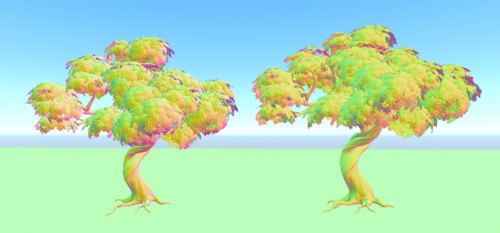
Quick summary for the game ready textures :
- Albedo + Channel alpha for the transparency (32 bits tga)
- Normal (24 bits tga)
- Metalness/Roughness (24 bits tga). The Red Channel has the metalness information. The Green Channel has the roughness information and the blue one is empty (black).
Modo
- Create a plane and apply your new billboard texture.
- Use the pen tool to draw a plane that covers the billboard. Try to make the plane silhouette match the billboard image as closely as possible to reduce the number of rendered transparent pixels.
- Apply the material on the new billboard asset and adjust the UV.
- Export your asset like you usually do
Editor
- After importing the billboards to the editor, check BillboardY in the model component to make the billboard follow the camera on Y-axis.
End result under some specific lights :
